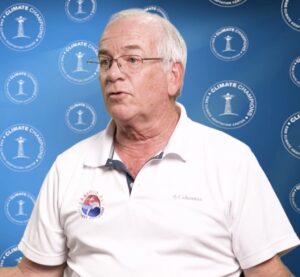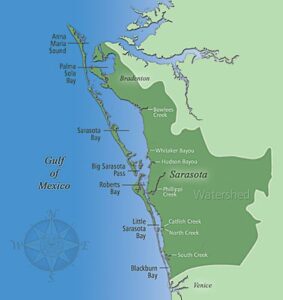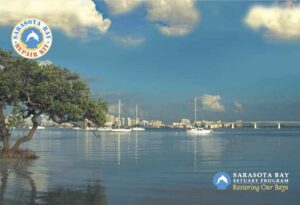Five days later, the money started flowing again. But the incident created havoc and uncertainty.
Johannes Werner
Original Air Date: Feb. 5, 2025
Host: Maybe it was the result of a lawsuit by a coalition of non-profits; maybe it was not. What we do know is that a seemingly sweeping executive order by incoming President Donald Trump to freeze federal spending has thrown into chaos thousands of ongoing programs throughout the nation, including here in Florida. We also know that on Monday, a judge extended a restraining order that forces the Trump administration to resume payments. Tuesday early afternoon, we talked to the head of the Sarasota Bay Estuary Program about how the federal freeze affected the small institution. Just hours after the interview, as of Tuesday evening federal funds were flowing again. Nevertheless, uncertainty seems to be the name of the new game.
Johannes Werner: The Sarasota Bay Estuary Program employs five, and its task is to monitor water quality in the bay and help mitigate water quality problems. It is funded in part by local and state money, but federal funding makes up 70 percent of its budget. Most of those 70 percent—for reasons unknown to Dave Tomasko, executive director of the Estuary Program—was not frozen. But there is also $4.5 million from a bipartisan bill for habitat restoration programs provided by the Environmental Protection Agency, also known as EPA. And that money was shut off last week when Trump imposed the freeze.

Dave Tomasko.
Dave Tomasko: What has been frozen is our access to what we call the Bipartisan Infrastructure Law funds. About three years ago, I think it was, we were given an appropriation by Congress—it was bipartisan; Mitch McConnel signed off on it, for example—and it gave us $4.5 million, potentially, over five years, to do habitat restoration projects. We’ve completed three of them already. Now we cannot access those funds, so we’re stuck with a situation where we have 11 projects we were going to do. Three we have completed. Four projects are underway right now, and we had to basically stop all further action on the four projects that are underway.
JW: The freeze not only stopped seawall enhancement projects underway at Martin Luther King Park on Whitaker Bayou in Sarasota and on Longboat Key, but it raised a big question mark over 11 other habitat restoration programs.
DT: We’re kind-of in this weird place where we have four projects underway, and if we can’t get this money or we can’t find a way to finish the project, then we will have effectively wasted $300,000 on design, permitting, and initial construction for projects that we can’t complete.
JW: Tomasko said the EPA gave them five hours advance notice of the freeze and then stopped responding altogether to any questions for five days. Tomasko used the heads-up to urge contractors and suppliers to send invoices. But by the time some $200,000 worth of bills had piled up, the money flow had already stopped.

Map of Sarasota Bay used in the Sarasota Bay Estuary Program’s Five-Year Habitat Restoration Plan (2016).
DT: We were told “the money’s going to go away.” We have a five-hour notice that this was going to happen, so we reached out to all our contractors and consultants and said, “Hey, send us your invoice because I don’t know if I can pay your bills after 5:00 Tuesday.” Folks were responding, and actually the portal closed down before 5:00 Tuesday. We actually received $200,000 worth of invoices, and now I can’t pay those invoices with the funding source I was gonna pay, so we have to take it from somewhere else. We’re going to have to take our money out of reserves.
JW: What shocked Tomasko most was the lack of communication.
DT: If we knew that there was a deadline and we just had to hold on for a little while, that would be one thing, but the folks from the EPA have been told not to contact us—not to talk to grant recipients like ourselves. We’re not getting any information out of the EPA at all. And these are good people who have been told not to communicate with us, so we don’t know when it’s going to end. People might say, “Well, Feb. 10 is in that OMB memo.” Feb. 10 is the deadline for agencies to go through thousands of programs, fill out a spreadsheet, and then present it to what is supposed to be a political appointee who then determines whether or not the program should live or die.

Cover page of the Sarasota Bay Repair Kit, a document by the Estuary Program.
JW: After five days, the federal grant funding began flowing again. But beyond the short-term upheaval, the incident has raised questions about the long-term viability of the Estuary Program as an employer, according to Dave Tomasko.
DT: I tell you, if the staff find out that all the EPA money goes away because of things that they don’t like, then we’re not going to last three months because everyone’s going to be looking for another job over the weekend. It’s not there yet—hopefully it never gets there—but if EPA decides not to fund the National Estuary Program, there’s real-world implications, and our Sarasota Bay Estuary Program—which we think, working with our partners, has turned around the health of the bay—we’re not going to be around. I won’t be around. I’m not going to work for a place where the funding is so insecure and the commitment from the federal government is not there anymore. It’s been there for 35 years, but now the commitment of the federal government to support the Estuary Program—I’m not sure it’s there. It’s been there for 35 years, but over the last two weeks, I’m not sure that commitment is there anymore.

A logo used for the Department of Government Efficiency (DOGE).
JW: One of his concerns is that the program may fall victim to the culture wars.
DT: We don’t know who the political appointee is. We don’t know if they’re going to basically not fund the Estuary Program because we talk about climate change. If that’s the case, then we will go away. The Estuary Program will go away if the federal government decides that they can’t fund a program that mentions climate change, because you can’t talk about managing water resources in Florida without talking about how our air is changing, our water is changing, our sea level is increasing, the frequency of storms is increasing—so if we can’t talk about climate change, we can’t do our job. The concern is, maybe someone in DOGE decides, “No. That mentions climate change. We’re not going to fund it.” If that’s the case, then the Estuary Program goes away.
JW: We reached out to the EPA, but a spokesperson said they cannot comment on pending litigation.
We also reached out to Sarasota County to find out whether their $200 million-plus in HUD disaster recovery funding has been affected.
Here is what a spokesperson told us:
“At this time, we have not been made aware of any impacts to the operations of the Resilient SRQ programs we administer. We have contacted the U.S. Department of Housing and Urban Development (HUD), the federal agency funding Resilient SRQ, to request further guidance and are awaiting their response. We’re monitoring the situation while moving forward as usual.”
Reporting for WSLR News, this is Johannes Werner.
WSLR News aims to keep the local community informed with our 1/2 hour local news show, quarterly newspaper and social media feeds. The local news broadcast airs on Wednesdays and Fridays at 6pm.